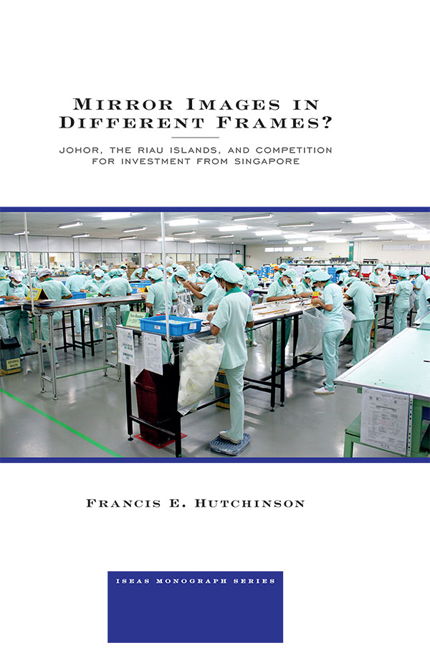 Mirror Images in Different Frames?
Mirror Images in Different Frames? Book contents
- Frontmatter
- Contents
- List of Tables
- List of Figures
- Editorial Note
- Acknowledgements
- About the Author
- List of Acronyms
- 1 Introduction
- 2 Theoretical Framework
- 3 “Internal State Architecture” and Incentive Structures for Meso-Level Leaders
- 4 The Cases: Johor and the Riau Islands
- 5 Conclusion
- Endnotes
- References
1 - Introduction
Published online by Cambridge University Press: 15 November 2017
- Frontmatter
- Contents
- List of Tables
- List of Figures
- Editorial Note
- Acknowledgements
- About the Author
- List of Acronyms
- 1 Introduction
- 2 Theoretical Framework
- 3 “Internal State Architecture” and Incentive Structures for Meso-Level Leaders
- 4 The Cases: Johor and the Riau Islands
- 5 Conclusion
- Endnotes
- References
Summary
Driven by substantial cost advantages and proximity, industrialization processes have closely linked Singapore with its two immediate neighbours — the Malaysian state of Johor to the north; and Indonesia's Province of the Riau Islands to the south. Further encouraged by tax incentives, multinational firms headquartered in Singapore have established affiliates in one or both territories, and a well-developed network of couriers and logistics firms link operations across these locations almost seamlessly.
With a population of 3.3 million and a territory of some 20,000 square kilometres, Johor was, until recently, a plantationdependent economy. Following a downturn in agricultural prices in the 1980s, the state embarked on an export-oriented industrialization drive, seeking to “twin” with Singapore to acquire technological know-how and capabilities. A number of similar economic strategies have followed over the subsequent decades. At present, Johor houses one of Malaysia's three centres of industry, with an important concentration of electronics firms — many linked into Singapore-based regional headquarters. Of late, the state has sought to attract more value-added service activities, and, in 2012, its economy grew by 6.5 per cent (Department of Statistics 2013, p. 9).
To Singapore's immediate south, the Province of the Riau Islands (PRI) has a population of 1.7 million, and a land area of 8,200 square kilometres scattered across some 2,400 islands. The better known islands include: Batam, which includes the province's economic capital, Batam city, and much of its manufacturing sector; and Bintan, the site of the provincial capital, Tanjungpinang. As with Johor, the Riau Islands were agriculturally focused, and have experienced a similarly transformative industrialization process. Since 1990, substantial numbers of manufacturing firms have moved to the territory, linking the province to global production chains in the shipping and electronics sectors. At present, the secondary sector accounts for more than half of the PRI's regional Gross Domestic Product (GDP), making it one of the few locations outside Java to host significant manufacturing activities. Excluding the oil and gas sector, the Riau Islands is the second-richest province in Indonesia in per capita terms, growing at 7.6 per cent p.a. in 2011 (BPSb 2012, p. 147; BPSd 2014, p. 34).
The similarity in business cases put forward by Johor and Riau Islands Province — essentially more abundant land and cost-effective labour relative to Singapore — has meant that their industrialization processes have been quite analogous.
- Type
- Chapter
- Information
- Mirror Images in Different Frames?Johor, the Riau Islands, and Competition for Investment from Singapore, pp. 1 - 10Publisher: ISEAS–Yusof Ishak InstitutePrint publication year: 2015
